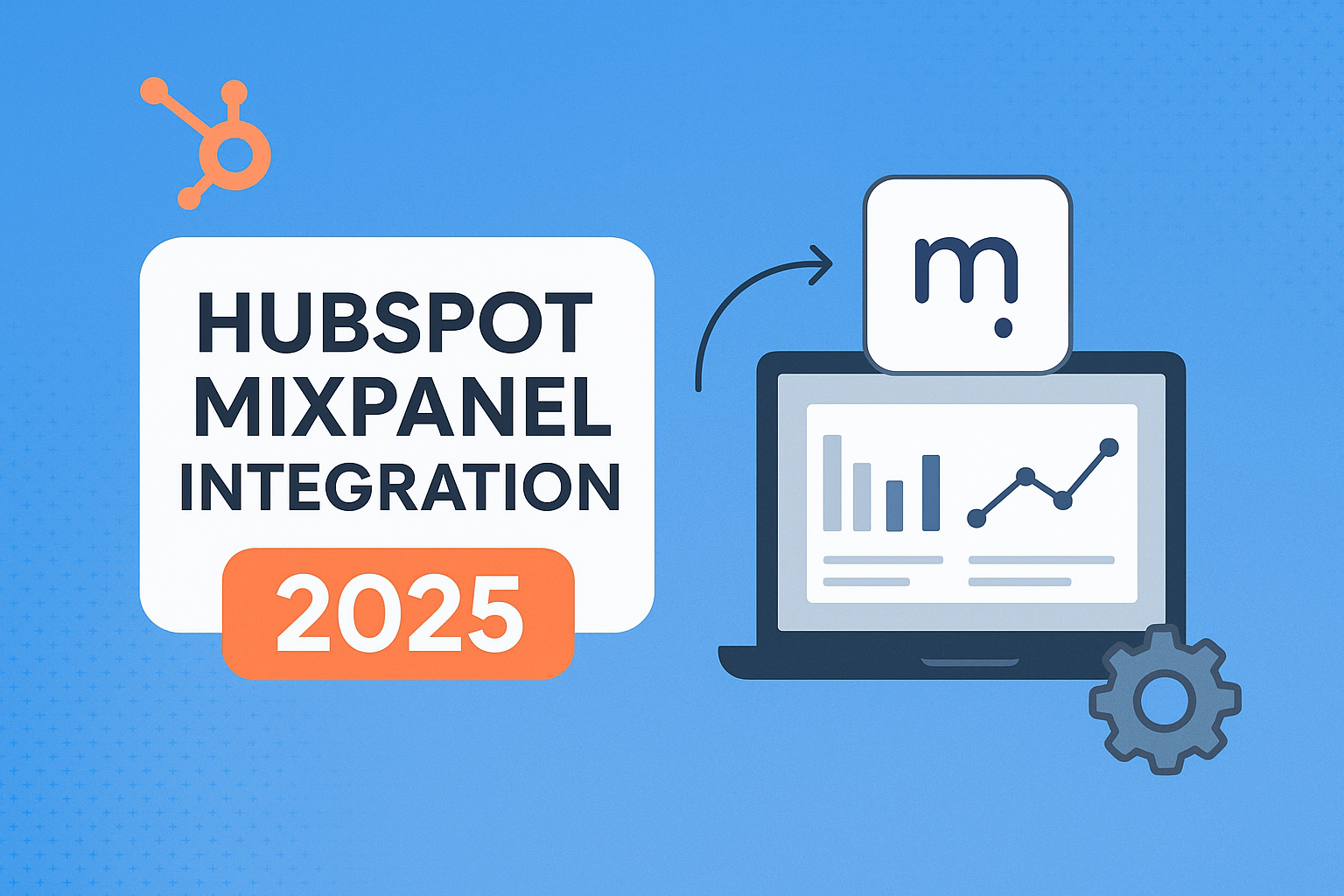
HubSpot Mixpanel Integration 2025: Step‑by‑Step Setup, Best Practices & Use Cases
Integrating HubSpot with Mixpanel in 2025 provides businesses with a robust solution to unify customer data, track user behavior, and improve decision-making. While HubSpot serves as a comprehensive customer relationship management (CRM) and marketing automation platform, Mixpanel specializes in advanced user analytics and product behavior insights. The combination of these two tools helps businesses create smarter marketing strategies and deliver personalized experiences based on real-time data.
At Product Siddha, we help businesses implement seamless integrations between HubSpot and Mixpanel. This enables teams to gain a holistic view of customer interactions, track conversion funnels, and measure engagement across touchpoints without the typical technical complexity.
Why Integrate HubSpot with Mixpanel?
HubSpot is widely used for managing inbound marketing, sales pipelines, and customer relationships. It excels at automating emails, managing contacts, and running campaigns. However, it offers limited depth when it comes to detailed behavioral analytics.
Mixpanel, on the other hand, focuses on event-based tracking. It enables businesses to understand how users interact with products or digital platforms by capturing granular behavioral data. Integrating the two systems ensures that marketing teams not only manage leads and customer journeys but also understand precisely what drives conversions.
Key advantages of the integration include:
- Enhanced customer segmentation based on behavior and engagement
- Accurate attribution of marketing efforts to user actions
- Improved visibility into customer journeys for better targeting
- Automated syncing of key events and contact data
Step‑by‑Step HubSpot Mixpanel Integration Setup
Step 1: Define Key Events and Data Points
Before connecting HubSpot and Mixpanel, outline the key customer actions and events to track. These typically include:
- Form submissions
- Email opens and clicks
- Website visits and page views
- Purchase or subscription completions
- Trial activations
This clarity ensures that only relevant data flows between the two systems, reducing noise and improving insights.
Step 2: Use an Integration Platform or Custom API
Several integration tools exist that facilitate HubSpot and Mixpanel connection without custom coding. Platforms like Zapier, Integromat, or native APIs allow you to automate workflows. Alternatively, Product Siddha recommends building a custom API connection for larger enterprises or unique business models requiring advanced data flows.
Example workflow:
- Set up a trigger in HubSpot for a contact property update (e.g., form submission).
- Configure an action in Mixpanel to log an event based on that trigger (e.g., “Form Submitted”).
- Map contact properties such as email, user ID, or campaign source for seamless tracking.
Step 3: Test Data Sync
Once the integration is configured, test it thoroughly. Ensure that events in HubSpot trigger corresponding events in Mixpanel. Check for:
- Accurate data mapping (no missing or misaligned properties)
- Timely syncing (data flows in near real-time)
- Proper event categorization
Validation helps prevent discrepancies that can lead to incorrect marketing decisions.
Step 4: Configure Dashboards and Reporting
Mixpanel offers powerful funnel analysis, cohort analysis, and retention tracking. Once the integration is active, build dashboards that reflect critical KPIs such as:
- Conversion rate per marketing campaign
- User activation trends over time
- Retention rates by customer segment
HubSpot’s dashboard can continue to show lead generation and contact management metrics, while Mixpanel provides deeper behavioral insights. This two-layered visibility helps both marketing and product teams collaborate efficiently.
Best Practices for HubSpot Mixpanel Integration
- Align on Common Identifiers:
Ensure consistent unique identifiers (like email address or user ID) across both platforms. This avoids duplication or misattributed events and helps connect CRM data to behavioral data cleanly. - Prioritize Relevant Events:
Avoid tracking every possible action. Focus on key events that directly relate to business outcomes such as trial sign-ups, product usage milestones, or payment completions. - Regularly Audit Data Integrity:
Set periodic checks to confirm that event flows remain intact. System updates, API changes, or platform upgrades can sometimes break integrations without clear alerts. - Leverage Cohort Analysis:
Use Mixpanel’s cohort functionality to segment customers based on behavior patterns. Combine this with HubSpot’s demographic data to deliver targeted marketing campaigns. - Automate Workflows with Purpose:
Automate follow-up tasks such as sending targeted emails when a customer performs a specific action. Well-crafted automation reduces manual overhead and increases relevance.
Real-World Use Cases
Case 1: SaaS Subscription Business
A SaaS company used Product Siddha’s expertise to integrate HubSpot with Mixpanel. By tracking trial activation events in Mixpanel and syncing them with HubSpot, the marketing team was able to target users who showed high engagement but hadn’t yet converted. This led to a 25% uplift in trial-to-paid conversion rates within three months.
Case 2: E-commerce Retailer
An online retailer combined HubSpot’s marketing automation with Mixpanel’s behavioral insights to monitor user paths from landing page to checkout. By identifying drop-off points through Mixpanel funnels and triggering personalized emails in HubSpot, cart abandonment rates decreased by 18% over six weeks.
The Role of Product Siddha in HubSpot Mixpanel Integration
At Product Siddha, we help businesses unlock the full potential of their customer data by implementing tailored HubSpot-Mixpanel integrations. Our approach goes beyond technical setup; we help define strategic KPIs, build data governance frameworks, and develop actionable dashboards that inform decision-making.
Whether your organization is just beginning to explore data-driven product management or you need advanced customization, Product Siddha ensures your tools work in harmony. Our experts bring decades of experience to help businesses streamline their data flows, enhance customer insights, and optimize marketing effectiveness.
Conclusion
Integrating HubSpot with Mixpanel in 2025 is more than a technical task; it is a strategic investment. It enables businesses to move beyond fragmented data silos and gain a unified view of the customer journey. The combination of HubSpot’s CRM and marketing automation capabilities with Mixpanel’s event-driven analytics empowers businesses to make informed decisions, automate processes, and improve user engagement.
For organizations seeking to sharpen their product and marketing strategies, adopting this integration with the guidance of an expert AI Automation Agency like Product Siddha is a logical next step. It drives efficiency, accelerates insights, and ultimately supports sustainable business growth.
Frequently Asked Questions (FAQs)
1. What are the key benefits of integrating HubSpot with Mixpanel?
Integrating HubSpot with Mixpanel provides a comprehensive view of both marketing and user behavior data. HubSpot excels at managing contacts, running email campaigns, and automating workflows, while Mixpanel focuses on in-depth event-based analytics such as user actions and feature adoption. Together, they allow businesses to segment customers based on behavior, track conversion paths, and attribute marketing efforts more accurately. The integration reduces data silos and improves decision-making by combining demographic, transactional, and behavioral insights in one place.
At Product Siddha, we help businesses implement this integration to deliver more personalized campaigns, accelerate the identification of friction points, and enable better product development strategies based on actionable data.
2. How does the integration improve customer segmentation?
The integration enables businesses to create advanced customer segments by combining HubSpot’s CRM data with Mixpanel’s behavioral events. For example, you can identify users who opened an email (HubSpot) and then viewed a specific product page or feature (Mixpanel). This two-fold insight allows segmentation based not only on profile attributes but also on actual engagement patterns.
As a result, marketers can target campaigns more precisely, such as re-engaging customers who showed interest but didn’t convert. Product Siddha’s expert consultants guide companies to implement data governance frameworks that improve the quality of customer segmentation, ensuring that segments stay relevant and actionable. Over time, this leads to higher conversion rates and improved customer satisfaction.
3. What is the recommended process for setting up the integration?
The recommended process begins with identifying the key events and data points critical to your business objectives. Next, decide whether to use an integration platform like Zapier or Integromat, or build a custom API solution if more flexibility is needed. Then, establish consistent unique identifiers such as user IDs or email addresses to match records in both systems. Once the integration is configured, test thoroughly to ensure accurate data syncing without duplication or errors.
Finally, build dashboards in Mixpanel and HubSpot that provide actionable insights, allowing marketing and product teams to analyze trends and make data-driven decisions effectively. At Product Siddha, we specialize in developing tailored HubSpot-Mixpanel integrations that align technical setup with business strategy, ensuring every data point serves a clear purpose.
4. What common challenges arise during integration, and how can they be avoided?
One common challenge is inconsistent identifiers between HubSpot and Mixpanel, which can result in fragmented or duplicate records. To prevent this, it’s critical to define a single source of truth, like a user ID or email address, and use it consistently across both systems. Another issue is event overload; tracking every single user interaction can overwhelm reporting and create irrelevant noise. Focusing only on meaningful events related to business goals helps maintain clarity.
Data syncing delays or failures may also occur if API rate limits are exceeded or configurations are incorrect. At Product Siddha, we address these challenges by implementing ongoing monitoring frameworks and periodic data audits. This ensures the integration remains accurate, efficient, and provides value over time.
5. How can businesses measure the success of HubSpot Mixpanel integration?
Success is typically measured through improvements in key performance indicators (KPIs) such as conversion rates, customer retention, and campaign ROI. After integrating HubSpot and Mixpanel, businesses should track the accuracy of data flows and the completeness of event tracking. Cohort analysis helps reveal changes in user behavior patterns post-integration. Additionally, the ability to trigger automated workflows based on behavioral events indicates successful implementation.
At Product Siddha, we help businesses build custom dashboards and reports that measure these KPIs consistently, providing clear insight into how marketing efforts impact product usage and customer outcomes. A successful integration connects marketing activities directly to measurable business results, creating a clear path toward sustainable growth.
